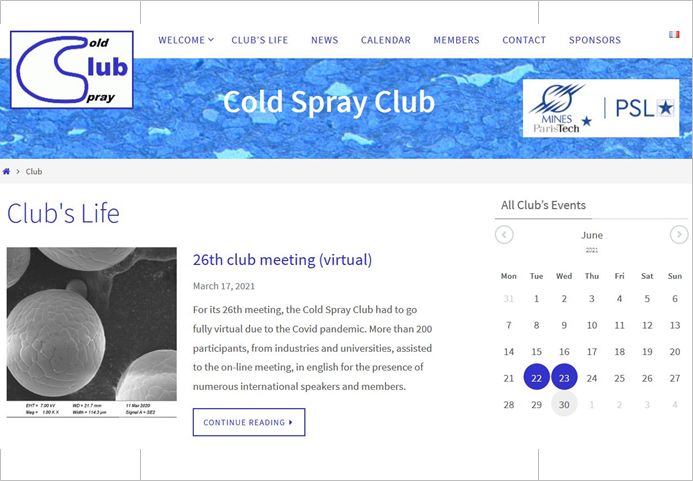



 Lecture
Lecture
Bio-based aerogels: new eco-friendly porous materials for thermal insulation and controlled release
_____________________________________________________________________________________
_____________________________________________________________________________________
The École des Mines de Paris / ARMINES, the Génopole and INSERM have created a common microscopy and site imaging center in Évry. In this context, the partners, strongly supported by the Region, have acquired a new transmission electron microscope: a Tecnai F 20 ST from FEI, operating at 200 KV.
This microscope has been installed in the Centre des Matériaux of the École des Mines de Paris, which is in charge of the management and routine maintenance, and which is also in charge of user training. The activity "Biology" and the activity "Physics of materials" share the time of use of the microscope at the rate of 50% each.
The concept of Tecnai microscopes focuses on the complete digital integration of all the signals collected by the column detectors. The images or analyzes of the same sample can thus be acquired simultaneously by the detectors STEM (Scanning Transmission) in darkfield and brightfield, EDX (X analysis), ELS / GIF (energy loss spectrometry / energy filtering). ), HAADF (atomic number contrast), video camera or CCD, and be viewed on the same screen.
The spatial resolution of the Tecnai F 20 ST in "High Resolution" mode (HRTEM) is 0.24nm, while it is 0.16nm in "High Resolution Sweep" mode (HRSTEM / HAADF). This microscope thus makes it possible to directly visualize, in many cases, the atomic columns of the materials.
|
|
This device, equipped with a field emission gun (FEG), is particularly well suited to EDX elementary chemical analysis, including light elements thanks to a very fine and very bright electronic probe, which allows to probe materials. at the nanometer scale.
Thanks to an excellent energy resolution (0.65eV), the Electron Energy Loss Spectrometry (ELS), in addition to the basic chemical dosing, gives access to the chemical bond and, in some cases, to the measurement of local properties (dielectric function, optical indices). Coupled with a system of filtering energy (GIF), as is the case on our microscope, it allows to acquire chemical maps in real time.
The Tecnai F 20 ST is a versatile device that perfectly meets the current demands of biologists and material physicists, but whose main characteristics are focused on elemental chemical analysis at the nanoscale. Regarding applications in Materials Science, it was chosen to meet the current demands of the Materials Center while allowing to address the materials of tomorrow. In liaison with the researchers of the laboratory and our external partners, this microscope plays and will play a determining role in the following lines of research :
_____________________________________________________________________________________
"Conventional" transmission electron microscopy, which allows diffraction analysis of crystallographic structures and imaging and analysis of dislocation microstructures in crystalline materials, has been used at the Materials Center since its inception. Several transmission electron microscopes particularly adapted to mechanical metallurgy activities have thus succeeded the CdM before the recent acquisition of Tecnai 30T operating at 300 kV.
The configuration of the microscope has been chosen to allow observation and analysis of microstructures ― in particular deformation microstructures ― of metal alloys (Nickel-based superalloys, steels, titanium-based alloys, aluminum alloys or Copper, etc.) for which the configuration of Tecnai F20ST is not optimized.
Thus, the characteristics of the LaB6 cathode thermoelectronic emission gun and the "Twin" objective lens, which leaves space for the use of a goniometric plate with large inclination angles, are particularly suitable for analysis. exhaustive of crystalline defects (dislocations, stacking faults) and the description of the dislocation microstructures in the samples taken from the specimens experimentally deformed in creep, stress relaxation, traction, fatigue (...) at the Centre des Matériaux. The configuration of this microscope lends itself particularly well to dark diffraction contrast imaging in weak beam ("weak beam") dislocations.
|
at 700 °C under 650MPa (dislocations et fautes d'empilement) dans le superalliage AD5 (champ clair) |
relaxation at 400 °C ("weak beam") |
The wide inclination amplitudes of the sample allowed by the goniometric stage, equipped with a "double tilt-rotation" object-holder, make it possible to reconstruct stereographic projections of the crystallographic structures of the precipitated phases that are sought. to identify.
|
et des précipités γ' et γ" dans le superalliage In718 |
In addition, the 300 kV acceleration voltage of the electron gun makes it possible to work comfortably on relatively thick areas of thin nickel-base alloys or elements of this atomic mass range (Iron, Copper, Cobalt, etc.)..
The Tecnai 30T is devoid of chemical analysis equipment but the total compatibility between its goniometric stage and that of Tecnai F20ST allows, when the chemical analysis of a phase observed ― and possibly analyzed in diffraction ― on the Tecnai 30T it is necessary to transfer the sample from one microscope to another without having to change the microscope and, as a result, risk losing the position of the observed zone. It is then possible to quickly carry out the desired chemical analyzes on Tecnai F20ST before eventually returning to complete his exams on Tecnai 30T.
The Tecnai 30T is particularly suitable for studies of deformation microstructures and precipitation microstructures in metal alloys based on relatively heavy elements. The observations and analyzes carried out on this microscope are essential in the research activities related to the following themes :
|
N19 superalloy (dark field) |
(bright field) |
_____________________________________________________________________________________

A new version of the COLD SPRAY CLUB website is now…
The COLD SPRAY CLUB concerns laboratories, technology…
> En savoir +

Formation
A MINES ParisTech PhD student awarded at the…
Josiane Nguejio, PhD student at Centre des Matériaux…
> En savoir +

Recherche
The FEMS Lecturers 2014-2015 include Henry PROUDHON
Lecturer Series This is a scheme which sponsors selected…
> En savoir +

Recherche
award for a team of Centre des Matériaux
Nicolas Gueninchault who work in teams M2 and COCAS with Henry…
> En savoir +
Recherche
The SF2M award three medals to doctors of the centre des…
The medal Réaumur is given by SF2M, each two…
> En savoir +
